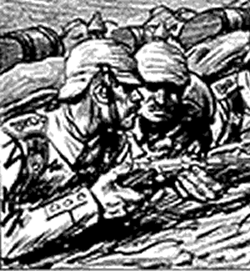 German soldiers wait for the order to attack
German soldiers wait for the order to attack
22 April 1915
Orders to Prepare for the Attack
According to the history of 215. Reserve-Infanterie-Regiment (46. Reserve Division of XXIII. Reserve Corps) the orders to carry out the attack were issued to the regiment at midnight [British time] on the night of 21st/22nd April. (1)
During the night the German troops already in the front line had been reinforced for the attack by soldiers moving into the line from the rear areas. The German trenches were packed tightly with men.
Preparations for the attack were complete:
- Respirators (i.e. the cotton mouth protector pads) were to be examined to check that they were damp;
- the German wire had been cut in front of the trench to enable the attackers to move forward more easily;
- sandbags were removed from in front of the batteries of gas cylinders and the pipes to dispel the gas were laid over the parapet.
At 05.20am orders were received by 215. Reserve-Infanterie-Regiment that the attack was to begin at 05.45am [British time].

|
The German soldiers waited in silence for the order to release the gas and start their advance towards the enemy line. A personal account by Leutnant Becker of III. Battalion 238 Reserve-Infanterie-Regiment (north-west of Langemarck) writes:
“In the morning the atmosphere was very tense. Pioneers were standing by the cylinders. In 10 minutes the gas would start to be released. But once again, as had happened two times in the previous days already, the wind changed direction.” (2)
Oberleutnant Mattenklott of the II. Battalion, 238 Reserve-Infanterie-Regiment wrote:
“At last the grey morning light began to dawn. But a favourable wind did not come with it. The wind remained weak without a definite direction. At 8.30am [British time] the battalion received the message that the attack would not take place before 4.00pm [British time] Everyone and everything was to stay where it was in the densely packed trenches.” (3)
Lack of Wind Delays the Attack
The wind needed to carry the gas in front of the infantry attack was not blowing. By 05.30am [British time] the attack was postponed. The troops nervously eyed the cylinders as they began a long and uncomfortable wait.
Already the problem worrying many of the German commanders regarding the reliance on the wind to start the attack had come about; preparations had been made for an attack in the early morning under cover of semi-darkness as dawn was breaking. With the attack's postponement the day had begun to dawn and the opportunity of surprising the enemy in the semi-darkness had slipped away. The dim visibility of twilight would also have provided protection for the attacking German soldiers as they crossed no-man's-land.
Leading on from this, with the attack being delayed further into the course of the day the reducing number of hours of daylight could become a further problem for the German troops; the fewer hours of daylight available to the attacking troops increased the disadvantages of being able to consoldiate captured enemy positions before sunset. Once darkness fell the difficulty of continuing with the attack or holding onto enemy ground would be increased.
A French Aircraft Chased Away
During the afternoon a single French aircraft flying over Langemarck village was heard by the crowds of troops waiting with bated breath in the front-line trenches. In the broad light of day the pilot might have easily seen the unusually large number of German troops packed into the forward area of the German front line. Had he been allowed to fly on over the German lines and report back to the French headquarters that he had seen the German troops ready to make an attack, the result could have been catastrophic for the German infantry here; a bombardment by Allied artillery on the German front line would not only have caused high German casualties in itself, but it could also have damaged the gas cylinders and caused gas injuries to the German Army's own men.
Fortunately for the nervous German soldiers, numerous batteries of German artillery focused their firepower on this plane and forced him to turn back across the Allied lines.(4)
TSignals for the Attack
During the day the waiting troops received an order informing them of what signals they should watch for which would indicate the start of the attack. In addition to messengers informing them of the time of the attack there would also be
- a red flare fired from a captive balloon at Houthulst Forest
- a shot fired by the “Big Bertha” gun onto Ypres.
Leutnant Becker of 238. Reserve-Infanterie-Regiment confirms this:
“The attack had to be postponed to the late afternoon. The assault troops were left in the trenches. They received the following order: that, towards the evening, as soon as the captive balloon floating over the Houthulst Forest had fired a red flare and “Dicke Bertha” [“Big Bertha”] had fired a first shot onto Ypres, the gas cylinders would be opened. The infantry was then to launch the attack.” (5)
Next>> Allied activity during the morning and early afternoon
Acknowledgements
(1) British Military Operations, France and Belgium, p. 191
(2) Geschichte des Reserve-Infanterie-Regiments 238, pp. 56-58
(3) Geschichte des Reserve-Infanterie-Regiments 238, pp. 59-63
(4) Gas! The Battle for Ypres 1915, p. 41
(5) Geschichte des Reserve-Infanterie-Regiments 238, p. 55
(Daheim) Artist's sketch from a German magazine 'Daheim!' printed in early 1915
.